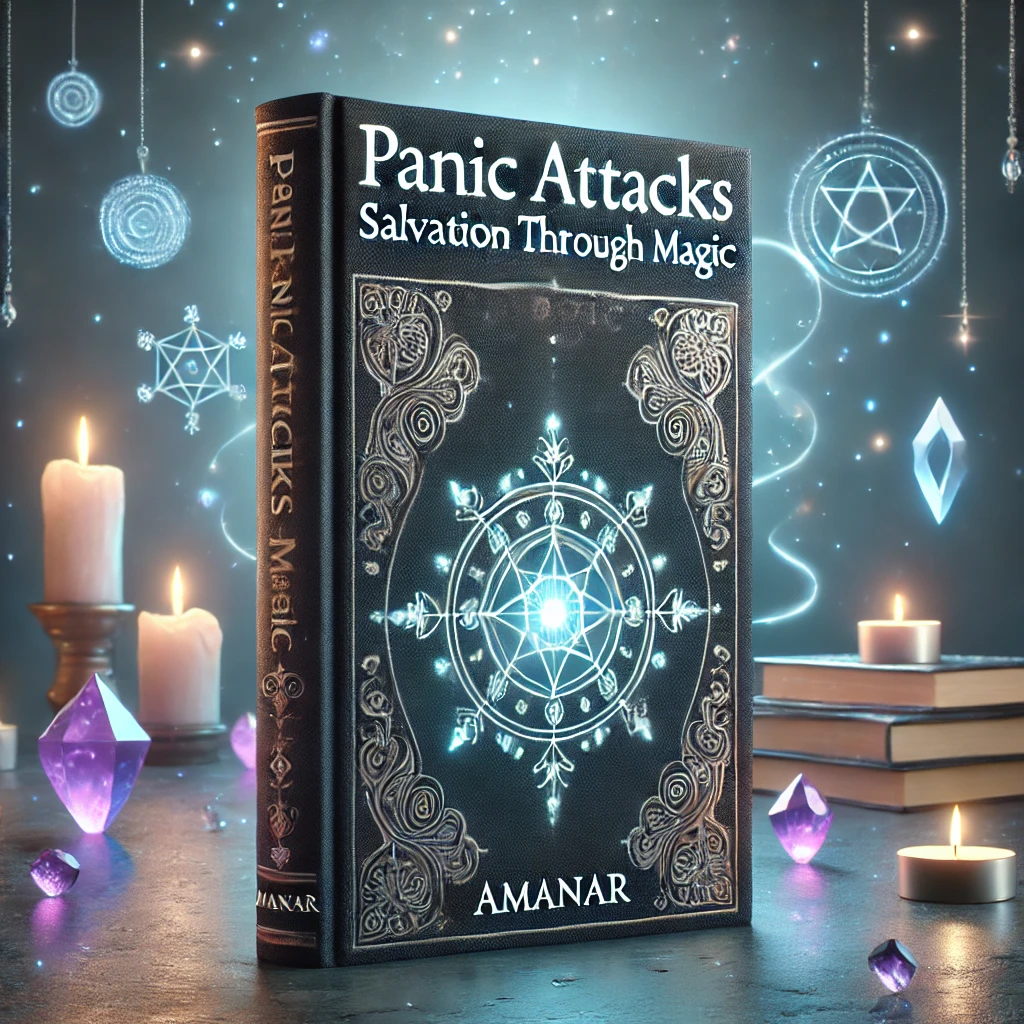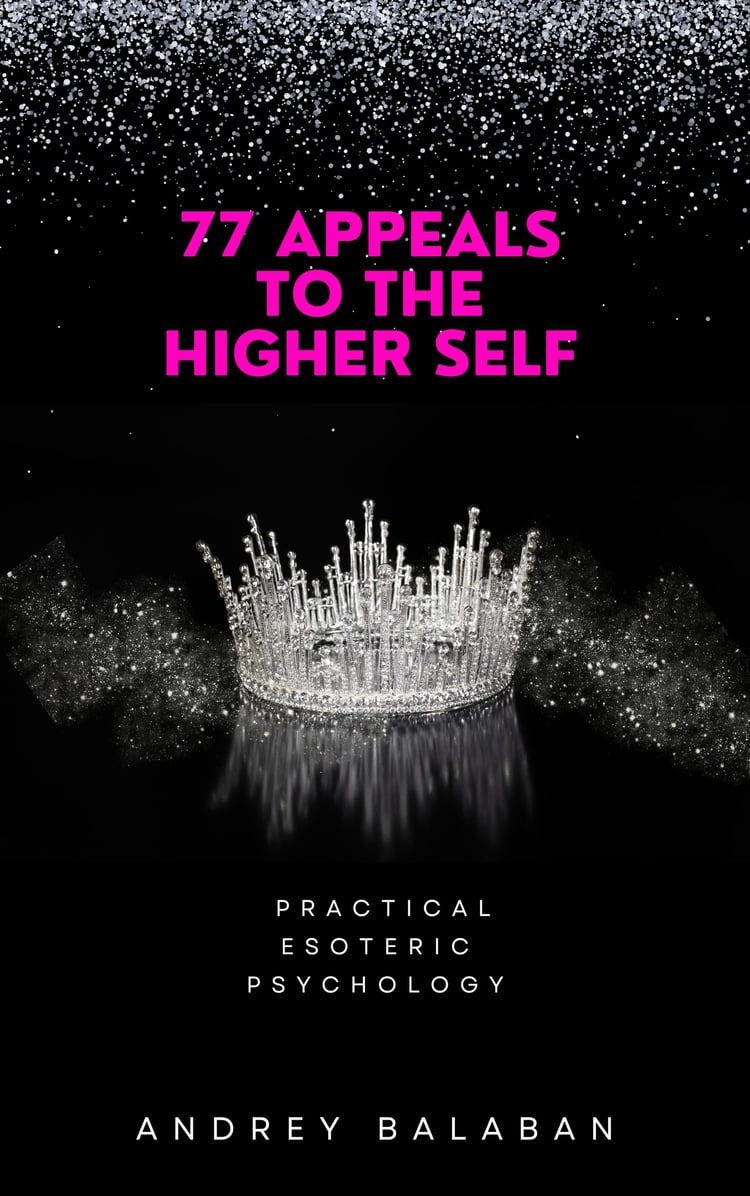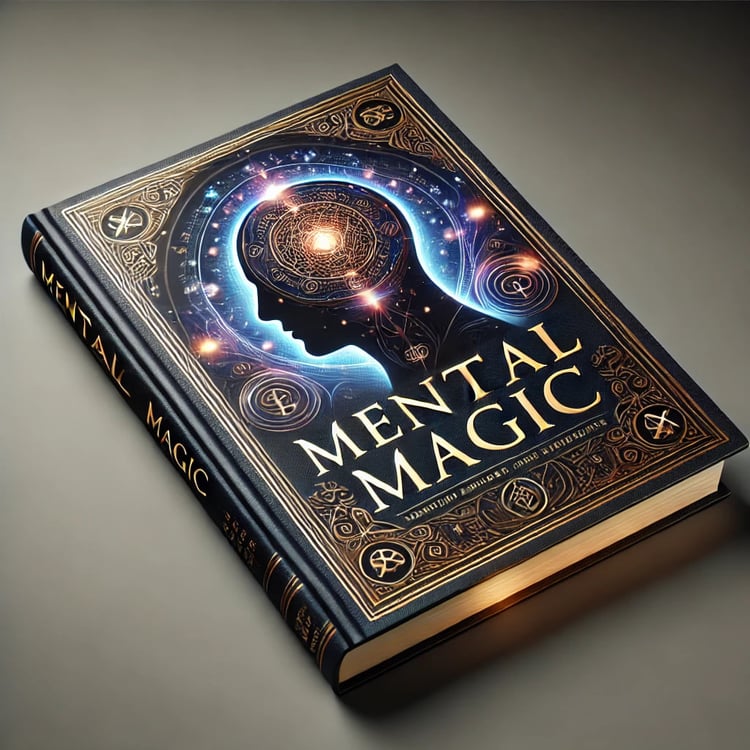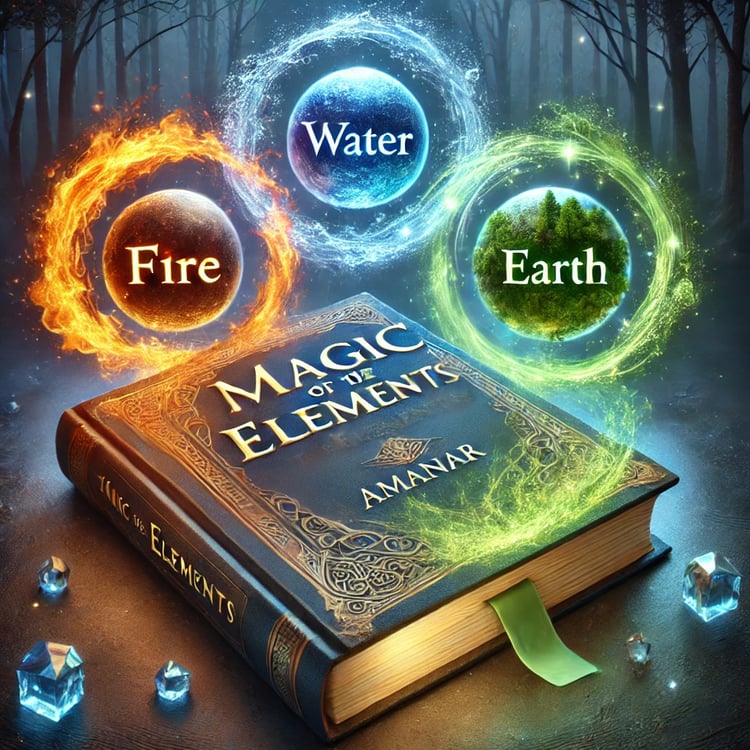
Amanar "Panic Attacks – Salvation Through Magic"
Introduction
A brief overview of panic attacks from both modern psychology and an esoteric perspective. The book’s goal is to show how ancient magical practices, sacred knowledge, and methods of working with consciousness can help in coping with panic attacks. It provides an outline of the book’s structure and the main topics to be explored.
Chapter 1. Panic Attacks: Psychological Foundations and a Magical Perspective
1.1. The classical definition of panic attacks in psychology
1.2. The neurophysiology of fear: how the brain responds to threats
1.3. A magical view of anxiety and fear
1.4. Synthesizing scientific and esoteric approaches for deeper understanding
Key Message:
Introduce the two “poles”—scientific and occult—to form a multidimensional view of the nature of panic attacks.
Chapter 2. The Origins of Fear in Esoteric Traditions
2.1. Ancient beliefs and the cult of “evil” spirits: how our ancestors perceived anxiety
2.2. Concepts of energetic imbalance in various magical schools
2.3. Personal “demons” as reflections of inner conflicts
2.4. The importance of recognizing the “shadow” in Jungian and occult contexts
Key Message:
Show how traditional magical systems have considered fear and anxiety since ancient times, and why their understanding remains relevant today.
Chapter 3. Preparing for Magical Work: Cleansing and Protection
3.1. Energetic hygiene: what it is and why it’s needed
3.2. Rituals for cleansing space (incense, salt, candles)
3.3. Creating a protective field (visualizing a “shield,” using sigils and pentagrams)
3.4. The importance of personal vows and intentions before beginning any practice
Key Message:
Before undertaking any magical practice or work on panic attacks, it is crucial to ensure energetic purity and establish a strong protective field.
Chapter 4. The Magic of Intention and the Power of the Word
4.1. How magical intention is formed and why it’s so important
4.2. The sacred power of words and their vibrations (why Latin and other ancient languages are effective)
4.3. Techniques for writing down intentions (grimoires, magical journals)
4.4. Integrating “willful” formulas into everyday life
Key Message:
Recognize that our words—spoken or written—have the power to create or destroy. Properly formulating intentions is the key to successful inner work.
Chapter 5. The Altar and Sacred Space: Setting Up a “Place of Power”
5.1. The significance of the altar in magical traditions
5.2. Choosing and consecrating a place for your practices
5.3. The symbolism of altar items: candles, crystals, herbs, talismans
5.4. Creating a “place of power” at home and maintaining its purity
Key Message:
An altar is not merely a decorative corner—it is a point of intersection for personal and divine power, where profound interaction with the Universe can occur.
Chapter 6. Rituals to Overcome Panic: Latin Incantations and Other Ancient Languages
6.1. Why Latin: a brief history of magical incantations
6.2. Examples of Latin formulas for calming the spirit (with detailed transcriptions)
6.3. Incorporating Ancient Greek, Sumerian, and other forgotten tongues
6.4. Creating your own incantation from archaic formulas
Key Message:
Demonstrate how the practice of using sacred languages can be a powerful tool for neutralizing episodes of fear and anxiety.
Chapter 7. Psychological Anchors and Magical Symbols
7.1. The “anchoring” technique in psychology: how associations are formed
7.2. Combining anchors with magical symbols (sigils, runes)
7.3. Using runes to stabilize one’s inner state
7.4. Personal protective signs and their role in daily practice
Key Message:
Reveal how to merge psychological methods of anchoring calmness with magical symbolism to achieve a deep and lasting result.
Chapter 8. Breathing Practices: The Bridge Between Body, Mind, and Spirit
8.1. Psychophysiological foundations of breathing techniques
8.2. The role of breath in rituals: “breath of life” and “breath of light”
8.3. The basics of pranayama in yoga and its effect on reducing anxiety
8.4. Breathing exercises paired with mantras and incantations
Key Message:
Show how proper breathwork influences both the nervous system and the energy field, forming the basis of both magical and psychological practice.
Chapter 9. Chakras and the Energy of Fear: Balancing the Inner System
9.1. A brief introduction to the chakra system and their functions
9.2. How fear and panic “get stuck” in lower centers (Muladhara, Svadhisthana)
9.3. Working with blockages: visualization, crystals, and breath flow
9.4. Practicing chakra cleansing and harmonization (meditation and incantations)
Key Message:
Recognize that panic attacks may be linked to energetic imbalances. Reestablishing energy flow is key to reducing anxiety.
Chapter 10. Yoga as a Magical Art for Overcoming Anxiety
10.1. A concise history of yoga and its spiritual roots
10.2. Asanas for fortifying the nervous system (Shavasana, Balasana, Vrikshasana)
10.3. The sacred aspect of yoga: mantras, mudras, and meditative practices
10.4. Creating a personal “yoga ritual” to prevent panic attacks
Key Message:
Demonstrate that yoga is not just physical exercise but a deeply magical path toward self-discovery and psychological resilience.
Chapter 11. Meditations and Visualizations: Gateways to the Subconscious
11.1. The differences between meditation and visualization
11.2. Techniques for deep relaxation and entering a trance state
11.3. Creating protective imagery and “inner power” spaces
11.4. Ritual meditations with candles and incense
Key Message:
Meditation and visualization are essential not only for calming the mind but also for unlocking hidden magical potential.
Chapter 12. Plant Allies: Herbs, Incense, and Aromatherapy
12.1. The magical and healing power of plants (mint, valerian, frankincense)
12.2. How to prepare calming herbal blends and infusions
12.3. Incense in rituals for anxiety (palo santo, sandalwood, sage)
12.4. Creating an individual “aromatic shield”
Key Message:
Plants have always been powerful aids in stabilizing the emotional state and protecting a person’s aura.
Chapter 13. Crystals and Minerals: Keepers of Magical Vibration
13.1. The energy of stones: how and why they affect our state
13.2. Crystals for combating anxiety (amethyst, moonstone, labradorite)
13.3. How to properly cleanse, charge, and program minerals
13.4. Placing crystals in the home and on the body for maximum benefit
Key Message:
Crystals are “living” conduits of energy. Used correctly, they enhance ritual practices and minimize panic episodes.
Chapter 14. Sound Therapy: Mantras, Gongs, and Tibetan Bowls
14.1. The effect of sound on the psyche and human biofield
14.2. Tibetan and quartz singing bowls in self-healing practices
14.3. Mantras as sound formulas (Om, Hrim, Shrim, etc.)
14.4. Using sound rituals at the first sign of a panic attack
Key Message:
Sound is one of the most potent vibrations for working with consciousness. Its healing influence dissolves internal blocks of fear and anxiety.
Chapter 15. Lucid Dreaming Techniques: Confronting Panic in Your Sleep
15.1. What lucid dreaming is and why it matters
15.2. Methods for entering lucid dreams (LaBerge’s technique, etc.)
15.3. Working with nightmares: transforming fear into an ally
15.4. Magical rituals before bedtime for protection and clarity
Key Message:
Dreams are a powerful arena for practice. Mindful engagement with symbols of panic in dreams transforms fear into a resource.
Chapter 16. The Magic of Tarot and Runes in Diagnosing Anxiety States
16.1. Tarot as a mirror of the inner world: analyzing the signifiers of fear
16.2. Runes and their use in uncovering the roots of panic attacks (Teiwaz, Algiz, etc.)
16.3. Spreads for self-analysis and rituals for “energetic reboot”
16.4. Safety in divinatory practices and protection from negative projections
Key Message:
Divinatory tools are not just for predicting the future; they can also be used to explore the subconscious, helping to reveal the deep causes of anxiety.
Chapter 17. The Role of Archetypes in Experiencing Panic and Finding Healing
17.1. Jungian archetypes: inner heroes, demons, and deities
17.2. Allegorical images of panic across cultures (Pan, Marduk, etc.)
17.3. Transforming the “victim” archetype into the “warrior”: practical exercises
17.4. Archetypal magic: rituals to invoke protective forces
Key Message:
Each of us carries powerful universal images within. Proper engagement with archetypes helps conquer inner conflicts and gain strength.
Chapter 18. Energetic “Parasites” and the Egregores of Fear
18.1. Collective egregores of anxiety: how they influence the individual
18.2. Signs of “attachment” to negative egregores
18.3. Rituals for severing energetic ties and freeing oneself from “parasites”
18.4. Practicing the formation of a positive self-support egregore
Key Message:
Fear is not always personal—it can be part of a collective field. Learning to “disconnect” and create a safe personal space is vital.
Chapter 19. Alchemical Transformation: Turning Fear into a Resource
19.1. The philosopher’s stone of inner metamorphosis
19.2. The principle of “solve et coagula” in working with panic
19.3. “Furnace” rituals: symbolically burning away anxiety
19.4. Crafting an “elixir” of courage and inner harmony
Key Message:
The alchemical approach teaches us to transmute the “heavy lead” of fear into the “pure gold” of awareness and determination.
Chapter 20. Group Rituals and Collective Practices
20.1. The power of the circle: why group work can exceed individual efforts
20.2. Shared cleansing and protection rituals for groups
20.3. How to maintain safe conduct within a group and avoid negative exchanges
20.4. Online group practices and digital magic in the modern era
Key Message:
Group dynamics can greatly amplify or diminish our energy. Properly organized collective rituals offer immense support in managing panic.
Chapter 21. Ethics of Magical Intervention and Psychological Boundaries
21.1. The difference between “white” and “gray” healing magic
21.2. The importance of respecting personal boundaries (yours and others’)
21.3. The danger of imposing help during psychological crises
21.4. Recommendations for collaboration with professionals (psychologists, psychotherapists)
Key Message:
Magical and psychological practices require mindful responsibility and ethical norms to avoid harming oneself or others.
Chapter 22. Crisis and Rebirth: The “Dark Night of the Soul”
22.1. Defining the “dark night of the soul” and recognizing its signs
22.2. Viewing crises as transitional stages of spiritual growth
22.3. Prayer, meditation, and other rituals for navigating severe challenges
22.4. Applying gained insights for further development
Key Message:
Periods of intense turmoil can lead to profound spiritual breakthroughs and a deeper sense of self-awareness.
Chapter 23. Eastern Practices: Tai Chi, Qigong, and “Dan Tian” Breathing
23.1. Introduction to Tai Chi and Qigong: why they’re effective for anxiety
23.2. Energy centers in Chinese tradition and their link to fear
23.3. Exercises to strengthen the “root” and calm the mind
23.4. Integrating Eastern techniques with Western magic and psychology
Key Message:
Eastern systems of body-mind development provide effective tools that can be woven into Western mystical and psychological frameworks.
Chapter 24. Mantras and Prayers from Various Traditions: Paths to the Divine
24.1. The difference between mantras and prayers, and their spiritual nature
24.2. Universal mantras for dispelling fear (Om Mani Padme Hum, etc.)
24.3. Orthodox, Catholic, and Buddhist prayers for easing anxiety
24.4. Personal practice of connecting with the Divine and one’s inner “Higher Self”
Key Message:
Appealing to spiritual powers is a vital part of the magical path. A prayer or mantra that resonates with your soul can transform emotional states.
Chapter 25. The Final Ritual of Liberation and Integration
25.1. Preparing for the culminating ceremony: summing up the journey
25.2. Creating a unifying altar representing all practiced techniques (symbols, talismans, crystals)
25.3. Conducting a grand ritual for releasing fear and panic
25.4. Consecrating a new life: solidifying results and looking toward the future
Key Message:
The final rite unites all the practices—psychology, magic, breathwork, spirituality—giving readers a holistic “transition point” to a life free from panic attacks.
Epilogue
A concise reflection on the entire journey, parting words, and recommendations for ongoing self-development. Emphasizes the importance of consistent practice and strengthening the connection with one’s inner world and the forces of the Universe. Encourages moving forward, using this knowledge to help both yourself and others.
Amanar










